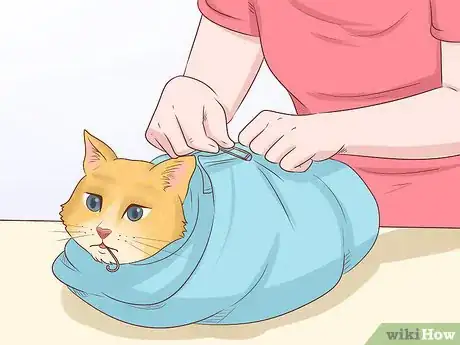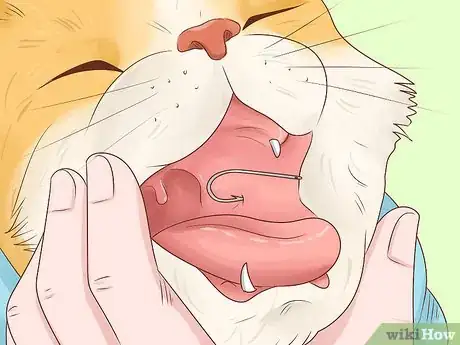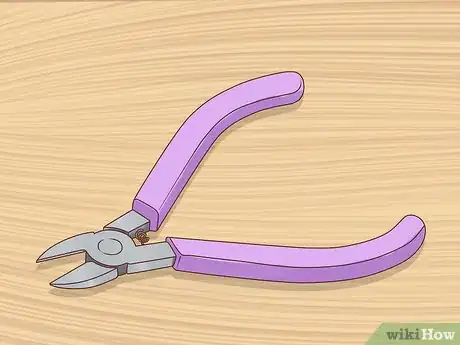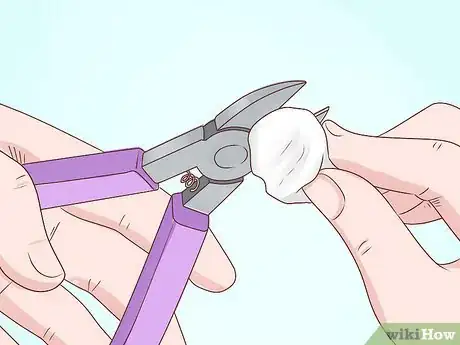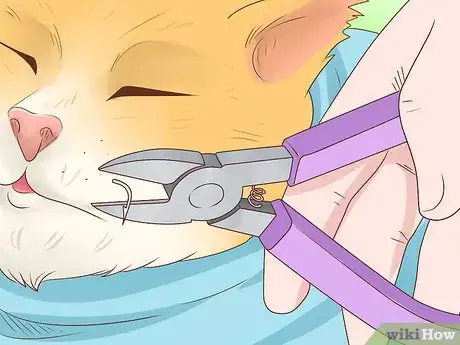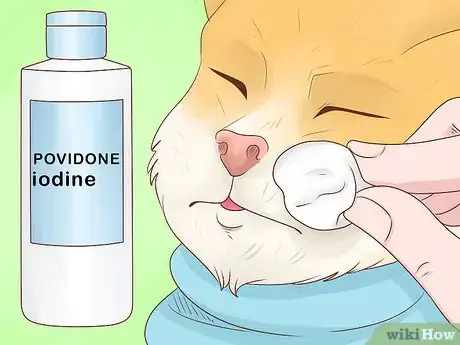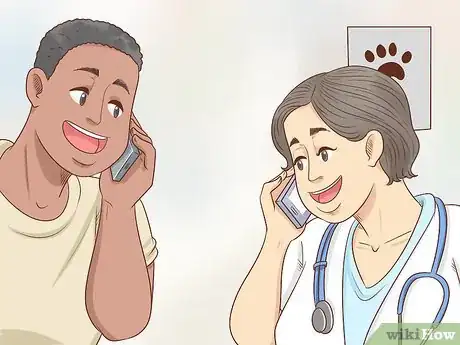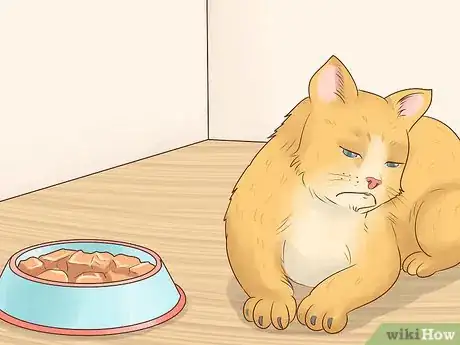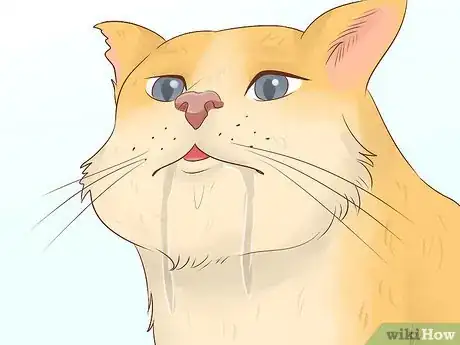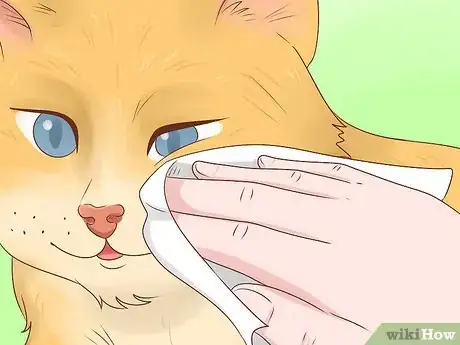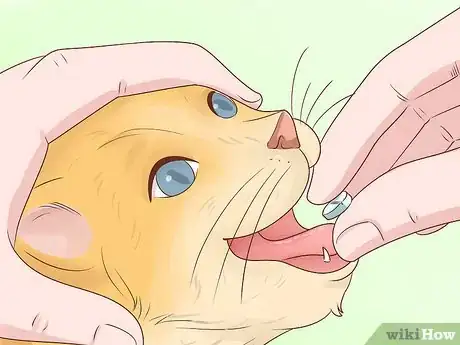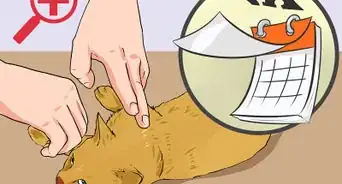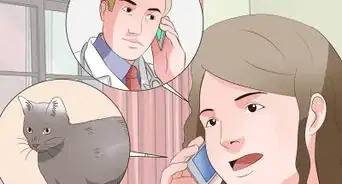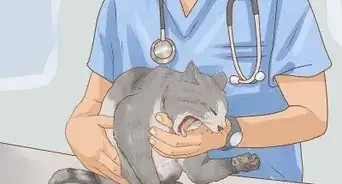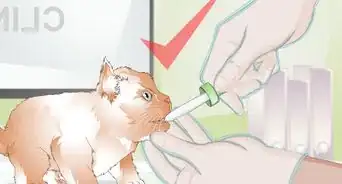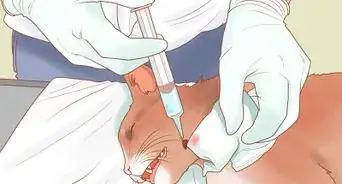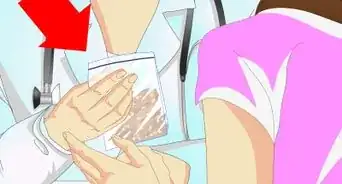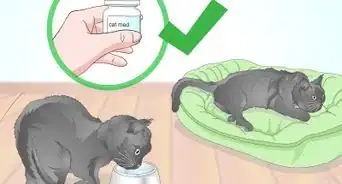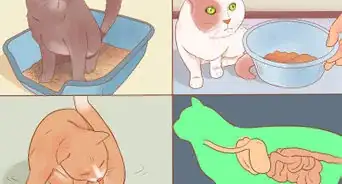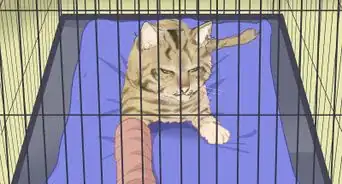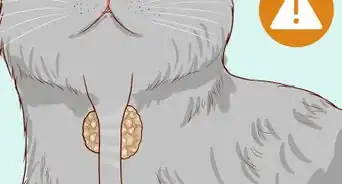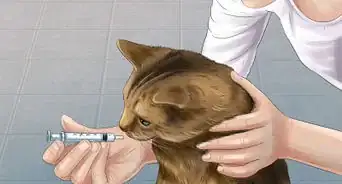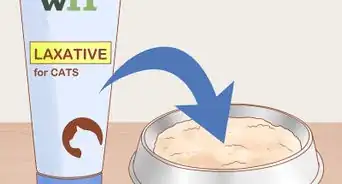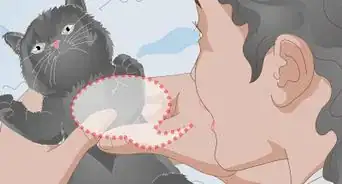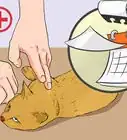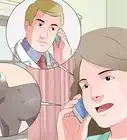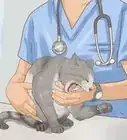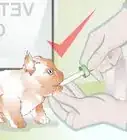This article was co-authored by Pippa Elliott, MRCVS. Dr. Elliott, BVMS, MRCVS is a veterinarian with over 30 years of experience in veterinary surgery and companion animal practice. She graduated from the University of Glasgow in 1987 with a degree in veterinary medicine and surgery. She has worked at the same animal clinic in her hometown for over 20 years.
There are 8 references cited in this article, which can be found at the bottom of the page.
This article has been viewed 16,579 times.
If you fish or live near a popular fishing location, your cat is at risk for getting a hook stuck in their mouth. These injuries are very painful and can lead to infection. If not treated quickly, they could be life-threatening. You need to recognize symptoms caused by such wounds, since many hooks are very small. In most cases, you should let your vet remove a hook from a cat's mouth. However, if the hook pierces through the lip, you can remove it with the proper precautions. Whether or not you can remove the hook, a trip to the vet is in order as soon as possible.
Steps
Removing the Hook
-
1Restrain your cat. If no one is available to help you, you'll need to wrap your cat in a large bath towel. Make sure their tail and all four paws are securely inside. Pin the towel closed with clothes pins.
- Alternatively, you could use a cat restraint bag, which you can buy in any pet supply store. Place the bag on the floor or other flat surface. Put your cat in the middle of the bag and begin to pull the sides up around them. Make sure their tail and all paws are securely inside the bag. Close the zipper and secure the neck hole.[1]
- If your cat fights back or runs away from you, don't make any further attempts to remove the hook. Wait for them to calm down and take them to the vet.
-
2Check the point of insertion. If the hook is stuck in the lip and if the barb of the hook is visible, you may proceed with removal. If you can't see the barb or if the hook is stuck inside the mouth or throat, take your cat to the vet immediately. In these more severe instances, you could make a dangerous situation worse if you attempt to remove the hook yourself.[2]
- Make sure that the whole barb has fully penetrated the skin so that you can see the shaft of the hook. If you can't see the whole barb, do not proceed with removal on your own. Instead, call your vet or local animal hospital.
Advertisement -
3Find a pair of wire cutters. Only wire cutters will work to remove a hook. If you don't have wire cutters, leave the removal to your vet. Never use scissors, a knife or any other sharp object. They could make the injury worse.[3]
-
4Sterilize the wire cutters. Pour some rubbing alcohol or hydrogen peroxide on a cotton ball or sheet of toilet paper. Wipe the blade of the wire cutters completely. Allow the antiseptic to evaporate to avoid poisoning your cat or damaging the injured tissue.[4]
-
5Cut and remove the hook. Use the wire cutters to snip the hook on the outside of the mouth below the barb. Remove the barb, and gently slide the shaft of the hook out of the mouth. DO NOT attempt to pull the hook in the opposite direction of where the barb is pointing. You could deepen the wound and risk infection.[5]
-
6Sterilize the wound, if possible. If you have povidone, dilute it until it's the color of weak tea. If you have chlorhexidine, dilute it until it's pale blue.[6] You could also use sterile saline if you have access to that. Soak a cotton ball or toilet paper with the solution and gently blot the wound. You can buy these antiseptics over the counter at any drug store.
- If you don't have these antiseptics, keep the wound clean with warm water and wait for the vet to sterilize it.
- Avoid hydrogen peroxide or rubbing alcohol. They can damage the injured skin even further.[7]
-
7Seek veterinary help. Do this after you have removed the hook. Don't wait to schedule an appointment. Inform your vet of the emergency situation and ask if they can squeeze you in as soon as possible. If it's after hours, call your vet's answering service. If your vet doesn't operate after hours, take your cat to the nearest animal hospital immediately.[8]
Spotting the Symptoms
-
1Look for changes in eating habits. Crunchy morsels of dry food can irritate open wounds in a cat's mouth. An injured cat might also have trouble swallowing because the hook is obstructing access to their throat. Because hook injuries happen suddenly, these symptoms arise out of the blue.
-
2Check for mouth rubbing. Your cat might attempt to remove the hook or scratch the source of irritation. Sometimes they'll use one or both front paws. At other times, they might rub their lips or gums on the floor.[9]
-
3Look for drooling. Drooling in cats is always a sign of illness or injury. When a foreign object like a hook gets stuck in the mouth, the body tries to remove it by producing excess saliva. You can spot drooling by wet fur around your cat's mouth.[10]
Helping Your Cat Heal
-
1Keep the external stitches clean. Check the wound after each meal. Gently brush or wipe away any remnants of food near it. Monitor your cat's behavior and stop them if they try to paw at the wound or rub it on the floor. Don't let your cat go outside until the wound is completely healed.
- Foul odors, chafing, and excess bleeding are signs of infection or other abnormality. If you notice any of these, contact your vet immediately.[11]
-
2Provide the prescribed medicine. Your vet will prescribe antibiotics either to fight an existing infection or to prevent one from developing. Follow the dosing instructions on the package. Don't stop giving your cat their medicine at the first sign of improvement. If the vet gives you a 10-day dosage, give the cat the medicine for the full 10 days.[12]
-
3Follow special dietary instructions. If the hook punctured your cat's gums or other areas inside the mouth, you'll probably have to avoid giving them dry food until the wound is completely healed. Chewed food particles can tear stitches. Your vet might prescribe prescription food for the healing period. Make sure you follow the instructions to the letter.[13]
Warnings
- Cats sometimes swallow hooks whole. This can be very dangerous. If you notice fishing line hanging out of your cat's mouth or if you think a hook is missing, contact your vet immediately.⧼thumbs_response⧽
References
- ↑ https://www.vetinfo.com/how-to-use-a-cat-restraint-bag.html
- ↑ http://www.peteducation.com/article.cfm?c=1+1411&aid=1566
- ↑ https://medlineplus.gov/ency/article/000055.htm
- ↑ http://teach.genetics.utah.edu/content/microbiology/solids/
- ↑ http://www.peteducation.com/article.cfm?c=1+1411&aid=1566
- ↑ http://www.petmd.com/cat/emergency/accidents-injuries/e_ct_wound_treatment
- ↑ http://www.cat-health-guide.org/catwoundcare.html
- ↑ http://www.petmd.com/cat/emergency/accidents-injuries/e_ct_wound_treatment
- ↑ http://www.peteducation.com/article.cfm?c=1+1411&aid=1566
- ↑ http://www.pethealthnetwork.com/cat-health/cat-diseases-conditions-a-z/why-do-cats-drool-its-never-normal
- ↑ http://www.petmd.com/cat/emergency/accidents-injuries/e_ct_wound_treatment?page=2
- ↑ http://www.cat-health-guide.org/catwoundcare.html
- ↑ http://www.peteducation.com/article.cfm?c=1+1411&aid=1566
About This Article
To remove a hook from a cat’s mouth, start by restraining it in a bath towel so its paws and tail cannot escape. If the hook is stuck in its lip and the barb is visible, go ahead and remove it. However, if you can’t see the barb and the hook is stuck inside the mouth or throat, take your cat to your vet right away so they can remove the hook. Once you’ve decided to remove the hook yourself, sterilize a pair of wire cutters by washing them with alcohol gel. Then, snip off the hook below the barb on the outside of the mouth. After you’ve cut the hook, gently slide it out of its mouth. Finish by cleaning the wound with a saline solution to prevent infection. For tips from our Veterinary co-author, including how to tell if your cat has swallowed a hook, keep reading!
